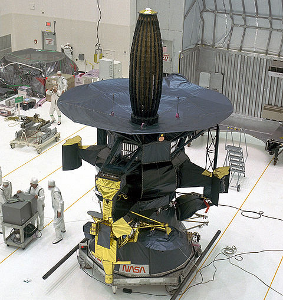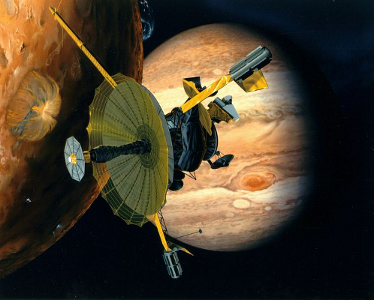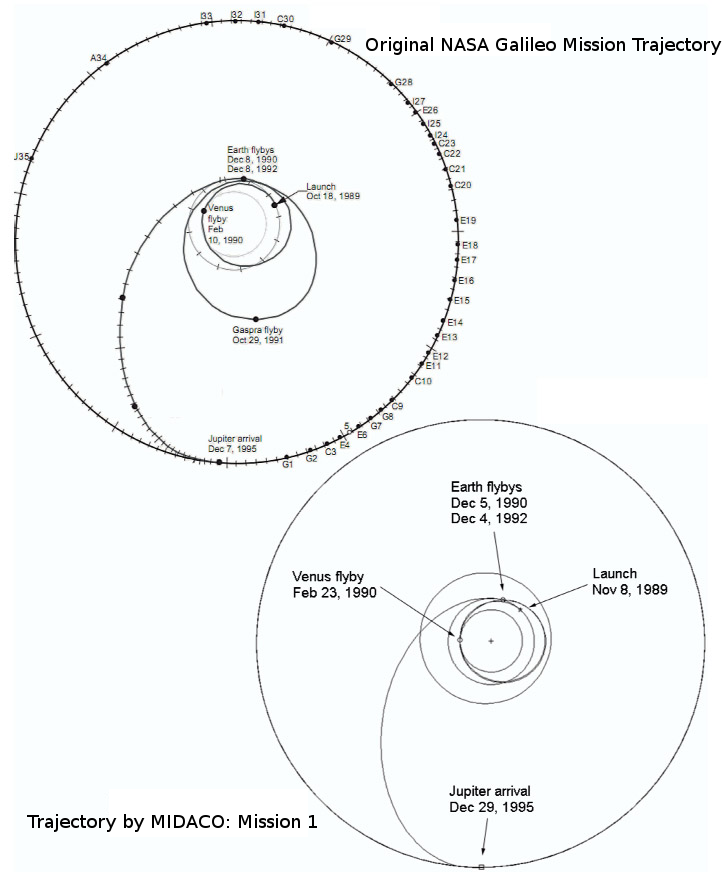Interplanetary Space Mission
In [1] (Section 4), MIDACO was used to calculate an interplanetary space mission trajectory from Earth to Jupiter. The trajectory model was based on the original Galileo mission launched by NASA in 1989. The space mission model was implemented in collaboration with the University of Birmingham (Rueckmann J, Schlueter M.), UniBW Muenchen (Gerdts M.), European Space Agency (Erb S.) and EADS Astrium (AIRBUS) (Kemble S.).
| Original NASA Galileo Spacecraft | Galileo Mission Artwork |
 |
 |
The considered mission model classifies as a multi-gravity assist (MGA or fly-by), deep space maneuver (DSM) trajectory. MGA-DSM optimal control problems are known to be challenging (see GTOPX database) and are therefore normally considered as purely continuous optimization problems only. Taking advantage of the performance capabilities of MIDACO, the mission model could be extended to the mixed integer domain: In addition to the continuous control parameters (such as launch date, fly-by altitudes and thrusting directions), MIDACO automatically selected the potential fly-by planets (e.g. Venus, Earth, Mars,... Pluto), which are represented by a categorical integer variable (e.g. Venus=1, Earth=2, Mars=3,...). This mixed integer extension makes the mission model considerably more difficult to solve, but also enables a much wider search space and relieves the space engineers from manually selecting the fly-by planets a priori.
| Galileo Mission | MIDACO Mission1 | MIDACO Mission4 | |
| Launch Date | 18 Oct 1989 | 8 Nov 1989 | 6 Jul 1989 |
| 1st Fly-By | Venus | Venus | Venus |
| Date | 10 Feb 1990 | 23 Feb 1990 | 21 Jan 1990 |
| 2nd Fly-By | Earth | Earth | Earth |
| Date | 8 Dec 1990 | 5 Dec 1990 | 4 Sep 1990 |
| 3rd Fly-By | Earth | Earth | Mars |
| Date | 8 Dec 1992 | 4 Dec 1990 | 31 Dec 1990 |
| Total Duration | 6.14 Years | 6.14 Years | 4.15 Years |
| Delta V | not available | 3.350 m/sec | 5.177 m/sec |
As a result, MIDACO was able to automatically generate a variety of feasible MGA-DSM trajectories from Earth to Jupiter. Those trajectories calculated by MIDACO with the lowest Delta V (which represents the propulsion of the spacecraft) are very similar to the original Galilelo mission and share the same characteristics (and fly-by planets!). The MIDACO Mission4 represents an alternative mission, which takes around 2 Years less on the total duration, but also requires significant more propulsion to achieve this.
| Comparison between original Galileo Trajectory and MIDACO solution | ||
 |
||
| Video Animation of MIDACO Mission1 | mission1.avi | (youtube) |
| Video Animation of MIDACO Mission4 | mission4.avi |
(youtube) |
Literature Reference
| [1] | MIDACO on MINLP Space Applications | JASR (Elsevier) Vol 51(7), 1116–1131 (2013) | Preprint |
|
A review articel on the paper in "Defense & Aerospace Week" is available here here |
|||
| Referee comments on the paper by the JASR journal are available here | |||
